Exploring Post Recaps, 2015–2016
September 19, 2016
Brittney Hubbard, M.S., RLAT, ARC Assistant Supervisor
Christelle Plourde, Supervisor – Animal Care
Julie Roller, M.S., RLATG, CMAR, Supervisor – Animal Care
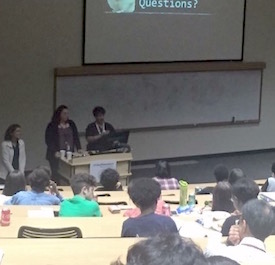
The meeting centered around the Animal Resource Center (ARC) with presentations by Brittney Hubbard, Christelle Plourde, and Julie Roller. They explained in detail the field of biomedical research, necessity of animal research, research topics/diseases, advantages of animal research and commonly used animals in research. Afterward, they talked about their part, as supervisors, in the care and husbandry of the research animals.
During the second part of the presentation, they addressed different career options for people with varied backgrounds (i.e. engineering, computer programming, security, HR, finance, administration, regulation and law) and how they are involved in biomedical research. They also encouraged the students to do their homework to prepare toward a suitable animal research career. The presentation ended with a virtual tour of the facility, followed by many questions.
May 23, 2016
Natalie Lundsteen, Ph.D., Director, Graduate Career Development and Stuart Ravnik, Ph.D., Associate Director, Graduate School and STARS
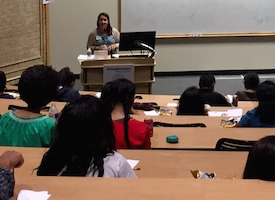
Natalie Lundsteen, Ph.D., Director of Graduate Career Development and Assistant Professor of Psychiatry, talked to students about having a good idea of what career to pursue. It’s important to know yourself and have a passion so that you are happy and satisfied with the work you do in life.
Dr. Lundsteen, who worked as a career counselor focusing on internships in universities such as Stanford, got kids involved in an activity. She used six letters RIASEC (R- Nature, hands-on, I-Investigative, curious, A-Artistic and creative, S-Helpful, social service, E- Entrepreneurship, sales, and C- Detailed work and tasks) to explain how jobs are divided. Students divided into groups based on their choice of letter and talked about jobs for each letter. Students also filled worksheets asking questions about interests and goals and were reminded that they should think about their future.
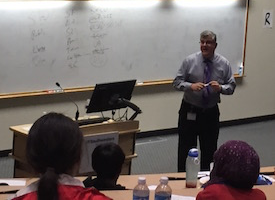
Stuart Ravnik, Ph.D., Associate Director of Graduate School and STARS, talked about the importance of deciding colleges. There are several criteria to decide a university and some of these include: private/public, size, and location (rural/urban). Students spent time choosing different criteria and looking at several colleges in areas of their choice. At the end, students and parents asked Dr. Ravnik’s opinion on several different universities.
April 25, 2016
Charlotte Haley, Ph.D., Assistant Professor, Psychiatry
Erinn Gideons, GSR Neuroscience
Officer Elections
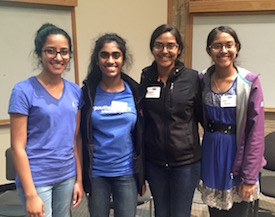
We started the meeting with our annual officer elections, followed by career presentations. Congratulations to Maya Reddi, Sasha Thomas, Varshini Suresh, and Dharshini Suresh for being elected as the 2016-2017 Exploring Post 1919 Officers!
Charlotte Haley, Ph.D., talked to students about mood, therapy, and anxiety disorders along with coping mechanisms. Teen stressors can include school, body image issues, peers, family, and social media. The main objective is to be positive. In general, stress management starts with recognition. Follow the SEE method (Sleep, Exercise, and Eat Healthy). It is important to set a positive tone daily and maintain wellness through awareness.
Erinn Gideons works in a research lab to find fast-working antidepressants. She went in-depth to explain depression. Antidepressants were accidently found during different clinical trials and were thought to affect monoamine transmitters such as serotonin and dopamine. She went on to talk about her research with ketamine. Ketamine does not affect the transmitters, proving that there are other factors to depression. Ketamine affects the production of BDNF, which proves to scientists that this field of science is expanding. She is continuing her research in the lab to answer more questions.
March 21, 2016
Angela Mihalic, M.D., and Stuart Ravnik, Ph.D.
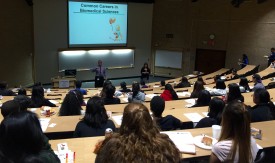
Angela Mihalic, M.D., Associate Dean of Student Affairs, and Stuart Ravnik, Ph.D., Associate Dean of the Graduate School, explained the basics of medical and graduate schools. They stressed the need to gain relevant experience as well as good grades, test scores, and relationships with teachers. Experience includes volunteering, attending summer programs, doing internships, performing research, and more.
Both fields are extremely hard and require sacrifices. It is important to care for the job and develop a passion and curiosity. Medicine has a more immediate effect on the patient and their lives while science can have a more broad effect on many people. However, both fields use the scientific thought method with hypothesis, experimentation, and observation.
Students gain entrance into medical and graduate schools through competitive application and interview processes. Medical school lasts for four years with an intensive schedule that finishes basic learning in a year and a half and starts clinical work, outside research, and integrated learning. UT Southwestern has extensive resources and state-of-the-art facilities for medical school.
Graduate school lasts around five years and encompasses research, projects, and scientific training, while receiving a stipend. For those who want to combine both M.D. and Ph.D. training, there is an exclusive MSTP program available that lasts around eight years and has a stipend and paid tuition.
Students enjoyed the presentations and asked many questions afterward.
February 22, 2016
Kristel Wright, Education Assistant
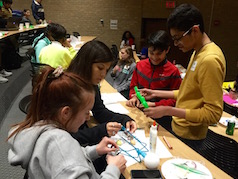
Kristel Wright, Education Assistant for AHEC, is interested in epidemiology, the branch of medicine that deals with the incidence, distribution, and control of diseases. She described several pathogenic microorganisms that were causes of major outbreaks during the Dark Ages such as the yellow fever virus. Wright went on to describe the major founders of important fields of science, i.e., John Snow, the father of epidemiology, and Louis Pasteur, the father of microbiology. She also talked about Alexander Fleming who accidently discovered the fungus that creates the famous antibiotic penicillin. Penicillin was a major antibiotic that killed several different types of bacteria until widespread bacterial antibody resistance became common. Some resistant bacteria are C. Difficile bacteria and enterobacteriaceae.
Epidemiology often includes the use of surveys, maps, and other data structures. Surveys showed that people were misinformed about antibiotics and resistance, which could lead to further bacterial resistance. Also, world maps were shown where different diseases were prevalent. These help in overcoming and learning more about diseases.
At the end of the talk, students had an opportunity to build their own bacteria or virus. In groups of four, they used supplies such as sparkly Styrofoam balls, cotton balls, Play-Doh, pipe cleaners, and other materials. They had fun creating personas for their bacteria, which included their names, diseases cause, and forms of transmissions. The meeting was wrapped up by presentations by groups.
December 14, 2015
Michael S. Brown, M.D.
Nobel Laureate
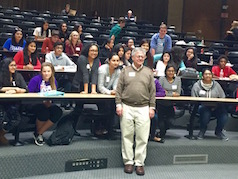
Michael Brown, M.D., and Joseph Goldstein, M.D., received the Nobel Prize in Medicine on December 10, 1985, for their discovery of low-density lipoprotein receptors that allow bodies to regulate cholesterol levels. This discovery led to the development of various medications called statins that are currently taken by around 20 million people across the world. Dr. Brown explained a little bit about his research, what sparked his interest in his area of study, his early life, and the day he received the award. Dr. Brown also shared the nine steps to earning a Nobel Prize:
- Be curious.
- Train with a Nobel Prize winner.
- Find a partner to share the adventure.
- Find a problem that fascinates you.
- Find someone to pay for your work.
- Work very hard.
- Solve the problem.
- Be lucky.
- Pick the right spouse (the most important one, according to Dr. Brown).
October 26, 2015
Christian Leal
Medical Student
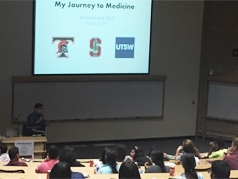
Christian Leal, former STARS summer research participant and current UT Southwestern medical student, graduated from Trinity High School and Stanford University, and received a degree in molecular and cellular biology. He talked about his path to medical school, medical school applications/interview and selection process, and the day-to-day life of a medical student. He talked about how he has overcome struggles and that everyone can do the same. He stressed the importance of community service, and discussed his consistent community involvement during college (medical interpreter at Stanford Medicine, Public Service Leadership Program, etc.) and how he wants to follow his passion to make the community a better place after medical school.
Antonio Fernandez-Perez
Graduate Student Researcher
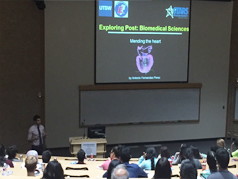
Antonio Fernandez-Perez is a graduate student in Dr. Nikhul Munshi’s lab working on heart development. He grew up in Tijuana, Mexico, before moving to California during high school. He attended community college, then transferred to the University of California in San Diego. He discussed his long path to graduate school and how his first research opportunity helped him choose a career path. After graduation, he worked at Sanford Consortium for Regenerative Medicine studying embryonic stem cells. Four years later, he started graduate school at UT Southwestern.
He chose to study cardiovascular disease and currently works with pluripotent cells to see if a fully differentiated cell can become another type of cell. In this way, they could take cardiac fibroblasts to make cardiac muscular cells. The end goal is to make a heart cell. He concluded his lecture by saying that the doors of opportunity are always open.
September 21, 2015
Andrew Nash and Michael Winters
Graduate Students, Prosthetics and Orthotics
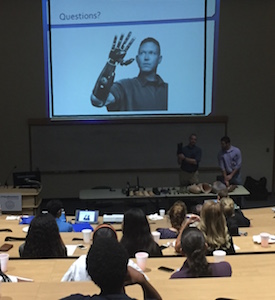
Andrew and Michael talked about their path to the Prosthetics and Orthotics graduate program. These are sciences that create limbs and other devices for veterans, diabetics, and patients. To get into the field of Prosthetics or Orthotics, you must have a bachelor’s degree with a variety of backgrounds such as engineering and biology. After the graduate program, you must attend residency, and take a certification exam. Then, you can work in hospitals, private clinics, and businesses.
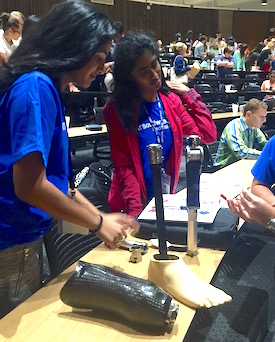
After the talk, everyone had an opportunity to do an activity: Each group of 5-8 students had to devise a prosthetic limb using parts such as a socket, pylon, and foot. The groups had to assemble the parts in a way that the leg could stand alone and bend at the knee joint.
Cyonna Holmes
Graduate Student Researcher, Biomedical Engineering
Cyonna Holmes is a graduate student in Biomedical Engineering (BME), where she is getting her Ph.D. and working in the cardiovascular and thoracic surgery department at UTSW. Cyonna attended Stanford Univeristy, where she enjoyed taking classes in science, math, and computer science. She also took a class in medical devices, and worked in a research lab in the summer.
In graduate school, she became interested in the heart after a rotation. There are several BME areas involved with the heart, such as stents, pacemakers, and assist devices. In the lab, she is finding ways to optimize transplant procedures. Her goal is to preserve the heart in a better way that would allow the heart to beat for longer periods of time.
In conclusion, biomedical engineering is a vast field that requires a good background of science and math. The field is booming and contains several opportunities to mix art and science and is especially great for those who want to help people.
